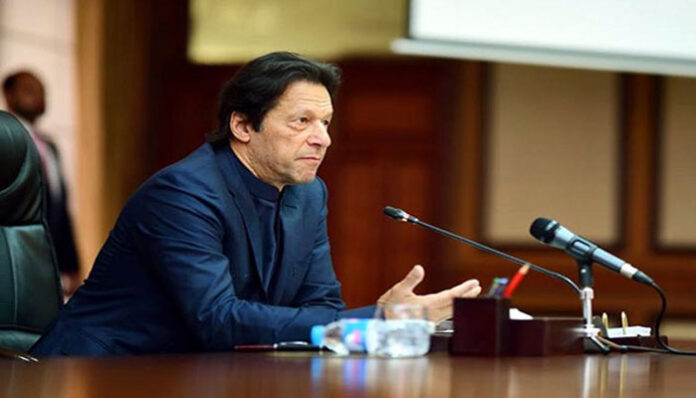–Meeting chaired by PM Imran decides to open 50,000 new utility stores across Pakistan
–Subsidised food items will be available to people from utility stores only
ISLAMABAD: Prime Minister Imran Khan on Monday decided to introduce a relief package of Rs15 billion for utility stores to tackle rising inflation and provide aid to the poor sections of society.
The decision was taken during a meeting of the government’s economic team chaired by the premier. It was decided that the relief will be provided on food items through utility stores while the administration will monitor the food prices at the district level.
The meeting was attended by PM’s Special Assistant on Social Protection Dr Sania Nishtar, Utility Stores Corporation Chairman Zulfiqar Ali Khan and other senior officials.
The meeting also decided to open 50,000 more utility retail stores across the country. The relief package for food items would be limited to the utility stores only and no plan has been devised to subsidies the commodities’ prices at private stores.
To set up utility stores, a loan worth Rs500,000 would be provided as part of the Kamyab Jawan Programme. In the initial phase, the government plans to establish 1500 such stores.
Addressing the meeting, Prime Minister Imran said that the government would leave no stone unturned to provide relief to the poor and salaried class against inflation. He added that the government cannot act as a silent spectator to the difficulties being faced by the poor people.
He also vowed to take stern action against hoarders and profiteers.
Inflation rate was clocked in at 14.6 per cent in January from 12.6pc of the previous month, scaling the highest level in 12 years, the Pakistan Bureau of Statistics (PBS) reported.
Inflation, measured by the Consumer Price Index (CPI), edged up 1.97pc over the previous month. Last time, the highest inflation in the country was recorded at 17pc in the year 2007-08.
The data released shows that higher food prices, particularly of wheat and flour, pulses, sugar, gurr and edible oil, were the largest driver of overall inflation in January.
It was also observed that the prices of essential food items, especially vegetable and fruits, are higher in rural areas than in urban areas. In rural areas, the prices of LPG cylinders used for cooking purpose have also witnessed highest ever increase since 2013.
The pass-through of exchange rate depreciation and higher international commodity prices, in addition to strong underlying demand pressures, started to reflect in higher year-on-year inflation from July 2019.
Food inflation in urban areas rose by 19.5pc in January on a yearly basis and 2.7pc on a monthly basis whereas it increased by 23.8pc and 3.4pc, respectively, in rural areas. It clearly shows that food inflation is very high in rural areas where most of the population lives, which is an unprecedented phenomenon.
In urban areas, the food items which saw an increase in their prices during January include: pulse moong 19.74pc, pulse gram 18.2pc, chicken 17.53pc, eggs 14.28pc, wheat 12.63pc, besan 12.09pc, fresh vegetables 11.7pc, pulse mash 10.29pc, gur 9.49pc, beans 8.09pc, wheat flour 7.42pc, pulse masoor 7.33pc, condiments and spices 7.15pc, gram whole 6.68pc, sugar 5.07pc, fresh fruits 3.93pc, mustard oil 2.87pc, wheat products 2.64pc, vegetable ghee 2.18pc, rice 1.2pc, fish 1.19pc and dry fruits 1.09pc.
On the flipside, items whose prices declined in urban areas include: onion 18.37pc, tomato 8.36pc and potato 3.69pc.
In rural areas the food items which saw a price hike include: pulse moong 18.7pc, chicken 17.3pc, fresh vegetables 15.39pc, pulse gram 14.21pc, eggs 12.89pc, gur 12.84pc, besan 9.97pc, wheat 9.07pc, pulse masoor 6.77pc, vegetable ghee 6.55pc, cooking oil 6.48pc, pulse mash 6.31pc, wheat flour 6.16pc, mustard oil 5.13pc, condiments and spices 4.85pc, beans 4.54pc, sugar 4.36pc, gram whole 4.22pc, dry fruits 3.54pc, butter 2.49pc, potato 1.96pc, meat 1.82pc, rice 1.77pc, wheat products 1.67pc and milk powder 1.4pc .
With the arrival of crops, especially vegetables, in Punjab, it is predicted that the prices of tomato, onion and potato and other vegetables will come down in February and March.
Similarly, non-food inflation in urban centres was recorded at 10.2pc year-on-year, while it was 10.5pc in rural areas. The rise in non-food inflation is mainly driven by an increase in oil prices over the past few months and a combined impact of depreciation of the exchange rate. The government passed on this increase to domestic consumers.
The International Monetary Fund has estimated that the country’s inflation may rise as high as 13pc, but the government estimates that it will remain within the range of 11-13pc for the current fiscal year.




